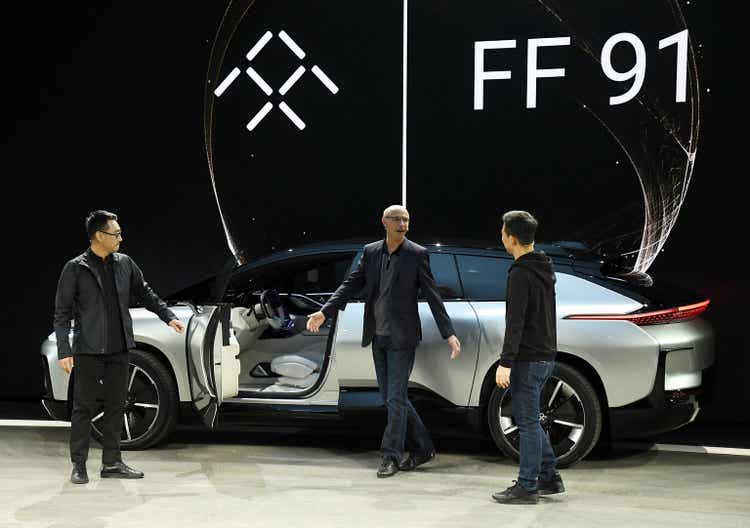Ethan Miller/Getty Images News
Faraday Future (NASDAQ:FFIE) reported cash and equivalents of $32 million against cash burn from operations of $120 million as of the end of its fiscal 2022 third quarter with capital expenditure during the quarter standing at $22 million. This meant the beleaguered EV company faced a liquidity gap that it had to plug with the issuance of new common shares and around $40 million of new debt. Cash and equivalents were down from $120.6 million in the prior second quarter with Faraday now facing the very material risk of running out of cash against ambitious plans to produce and sell the FF 91, its flagship luxury electric vehicle.
This is an unfortunate situation for a company that now seems to be heading towards what some bears say is the final stages of its nearly two-year stint as a NASDAQ-listed entity. Shares are trading below the $1 minimum listing requirement and management put out a going concern warning on Monday along with their latest earnings report.
Faraday was ambitious in its plans to tap into the growing popularity of EVs with the FF 91 targeting the high-end luxury market and with plans to eventually launch an FF 81 and FF 71 at later dates. These would target the fast-growing EV mass market. Indeed, growth is essentially set to go up with less than 1% of all passenger vehicles on US roads currently being EVs. The secular shift towards zero-emission transportation is now being fully included in the post-pandemic economic direction of developed countries and US states like California and New York. Both have instituted planned dates for the phase-out of sales of new gas and diesel-powered vehicles.
Faraday wants to tap into this secular shift to EVs that is still in a very formative stage and the pace of growth ahead will be significant. Just 120,000 EVs were sold globally in 2012, last year saw this figure being sold on a weekly basis with 10% of cars sold in 2021 being electric, 4x the market share in 2019. Sales of gas and diesel-powered vehicles already look to be experiencing a decline in certain developed markets with EVs forecasted to grow to at least 26.8 million by 2030, up from 6.6 million in 2021.
FF 91 Deliveries Are Up In The Air As Company Races To Raise Cash
The company’s hybrid approach to the production of its vehicles has been the main driver of the substantial operational cash burn which year-to-date stands at $355 million. The FF 91 will be produced at a currently being constructed manufacturing facility in Hanford, California named FF ieFactory whilst the future model FF 81 would be produced using a contract manufacturer in South Korea.
To intention of the in-house production of the FF 91 is to control all the touchpoints of its luxury and brand-defining automobile. Planned production from the Hanford facility is 10,000 per year and the company during its latest earnings report stated that the construction and equipment installation in the vehicle assembly areas of the factory has been completed. The core takeaway for current and prospective shareholders is that the pre-revenue company does not currently have the liquidity available to bring its car to market and arrest its share price decline.
The Road Ahead
The roadmap for the first FF 91 deliveries to meet preorders that stood at 369 as of the middle of November is uncertain and will hinge on currently ongoing fundraising efforts. The company was able to secure committed funds of $112 million in senior secured convertible notes as part of a broader financing facility which could see Faraday raise $600 million. Post-period end the company signed another financing agreement with Yorkville Advisors to raise at least $200 million. The fundraising efforts come on the back of a cost-cutting drive initiated during the quarter with some jobs eliminated and some employees being offered equity in place of salaries.
Faraday could pull itself back from the brink against this cash-saving drive and fundraising effort. The large operational cash outflows will demand a substantial huge level of efficiency savings to make a dent in the viscosity of the company’s cash burn. Further, whilst the committed funds look substantial, it’s important to note that the company scrapped its delivery timeline so will likely remain pre-revenue for longer than shareholders would desire.
Bringing a new car to market is not easy, Faraday has invested at least $2.4 billion to date to bring the FF 91 to market and is still an uncertain time away from this happening. The company’s success would be welcome as it would contribute to a healthy and competitive EV market, but prospective shareholders would be investing based on hope around stemming cash burn against constant dilution. This renders the shares an avoid.


Be the first to comment